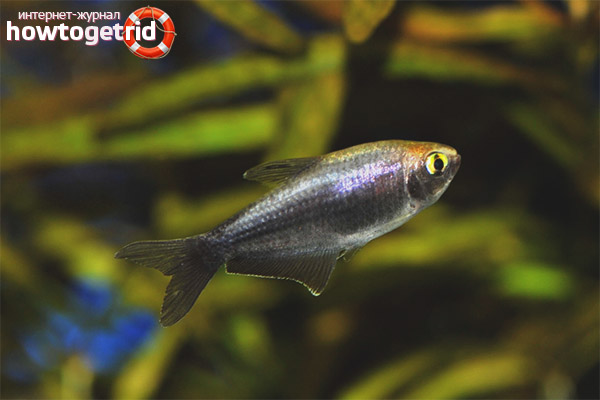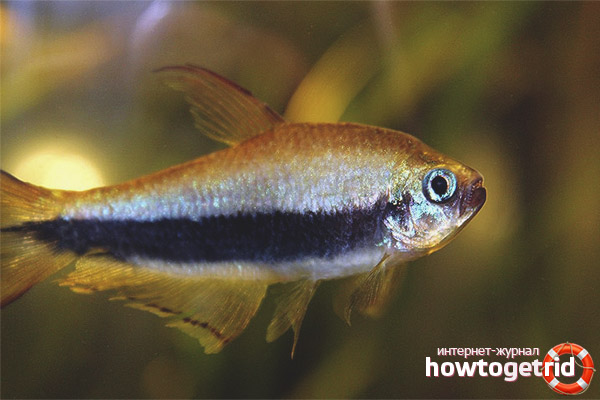The content of the article
The maintenance of the aquarium, the arrangement of the vital functions of fish, as well as the breeding of underwater offspring requires a lot of energy costs and patience, and most importantly, knowledge. Each fish needs special living conditions. Today we’ll talk about the royal tetra, or, as it is also called, palmery. This is a surprisingly beautiful and graceful marine creature, the fish gets along well with neighbors of a different species, lives relatively long, and even spawns under ideal conditions. In this article, we will analyze what the royal tetra is, how to look after it, what conditions of detention are necessary for this species, and also learn how spawning and the appearance of offspring of palmeri occur.
Royal tetra
Palmeri refers to fish of the order Carp-shaped, the haracin family. This species is absolutely non-aggressive, it gets along well with other tetras, swordsmen, lanterns, neon, pulchera, ornatus and other fish. The maximum body length is about 6-7 cm. The main color of the scales is golden, silver with a splash of blue and green shine. Along the whole body, the fish is decorated with a long longitudinal strip of black or bluish color. The fins are yellow, slightly transparent. The males of the royal tetra are larger, with a pronounced dorsal fin and long feathers of the caudal fin. A feature of the tetra is that the fish is able to swim upside down at an angle of 45 degrees. Palmeri will be a wonderful decoration for any aquarium.
How to keep a royal tetra in an aquarium?
The royal tetra belongs to rather unpretentious fish, even a novice aquarist can cope with its content. Here are a few aspects and important knowledge to help you care for your palmer.
- It is advisable to keep the royal tetra in small flocks, at least 5-6 individuals. Then they will sort things out in the clan group. Otherwise, fish may begin to bite the tails of other aquarium inhabitants.
- Due to the fact that the royal tetra is kept in flocks, for fish you will need a fairly large aquarium, not less than 60 liters.
- Comfortable water temperature for palmers is 22-26 degrees.
- The hydrogen indicator of water should be about 6.5-7.0.
- The water in the aquarium should be changed twice a month, draining the twentieth of the liquid from the aquarium and adding fresh, settled water without chlorine and other harmful impurities.
- Most modern aquariums are closed on top, that is, equipped with special covers. However, some lovers can still find "open" aquariums made by the artisanal method. They must be closed, otherwise the royal tetra can easily jump out of an artificial reservoir.
- Remember that fish get along well with other species, but not with predators!
- Feeding the tetra will not cause you much trouble. In nature, the fish eats small larvae, worms and other insects. In an aquarium, palmeri will not refuse either dry or frozen food. Try to use different compounds in the feeding, the more varied the nutrition, the brighter and more beautiful the color of the fish will be. To make palmeri not only beautiful, but also healthy, regularly change her diet from dry food to live and vice versa. In addition, you should follow the gastronomic preferences of the royal tetra. As a rule, the fish eagerly eats the food that is most needed. That is, if a live worm or bloodworm overlaps with a palmer, it means that there is not enough protein in its body, keep this in mind in subsequent feedings.Such an approach will help prevent many diseases against the background of a deficiency of protein or plant components in the diet.
- The natural habitat of fish is the Columbia River, in which dense and diverse vegetation is observed. That is why the tetra will feel much better if there are a lot of plantings in the aquarium. In addition, the dark embankment and the dense green color of the plants perfectly shade the color of the fish and make the royal tetra even brighter and more spectacular.
Summing up, we can say that the guarantee of the health of the royal tetra is based on three basic conditions - a good diverse feed, peaceful neighbors and clean water, which must be changed in a timely manner. Observe these conditions and the fish will delight you for a long time.
How to breed a royal tetra?

In most cases, the fish spawns itself and no conditions are required for this. However, if the clear goal is to achieve offspring, you should take care of this. As a rule, if there are at least 10 fish of different sexes in a school, then over time they themselves form pairs. It is not difficult to distinguish a female from a male - males are brighter and more beautiful. In addition, males have a pronounced blue iris, and in females this color is green.
In order to get a healthy and numerous offspring, the fish should be relocated to another aquarium, since during spawning they become quite aggressive. But before this, the male and the female should be held separately for several days, introducing only natural live food into the diet. After "feeding" the pair must be transferred to a separate aquarium, put on the bottom a bunch of small plants for spawning. Sprinkle the bottom with soil is not worth it, this will add you additional trouble when fry appear. Be sure to make dim lighting, as at the very bottom of natural reservoirs. This is a prerequisite for spawning, as the fish feel safe. Natural daylight is sufficient, but not direct. It is also important to keep the water in the pond soft.
Spawning, as a rule, begins at dawn, lasts several hours. During this period, the female lays up to hundreds of eggs. Sometimes parents themselves can start to eat caviar if some of the living conditions they think is not perfect. Therefore, you need to monitor the process and, if necessary, immediately remove the male and female from offspring. Within two days, the fry hatch from the eggs, which in 2-3 days will begin to swim independently. In the first days of life, babies should be fed with infusoria and vinegar eel - these little worms will make up for the lack of necessary substances and will serve as a great start in the life of new fish. When the new offspring is fully strengthened, they can be relocated to a common aquarium. This should not be done before - fry can become prey for larger fish. Even if you do not specifically care about breeding offspring, the royal tetra reproduces well and can increase the number of flocks 5-7 times in a year.
The royal tetra is an amazing, tenacious fish that adapts to different places of residence. Many aquarists admit that their journey in the world of artificial reservoirs began precisely with the Royal Tetra, because it survives even in the most difficult conditions, forgives the owner gross errors in content. Dumplings are an easy way to decorate your tank with vibrant colors and paints.
Video: Royal Tetra aquarium fish










Submit